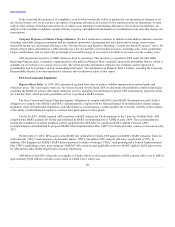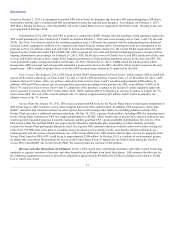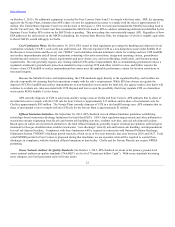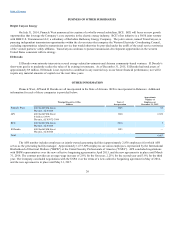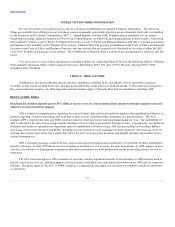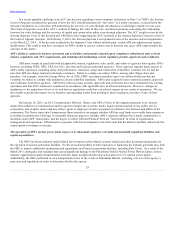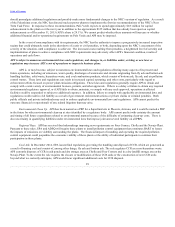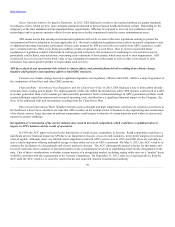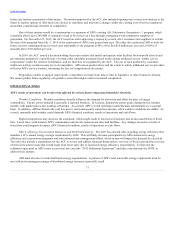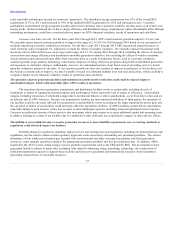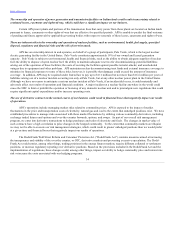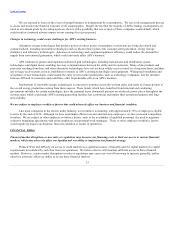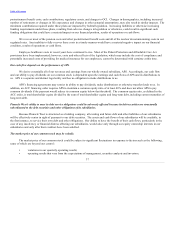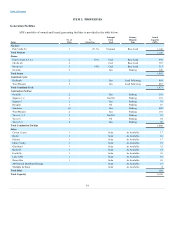APS 2015 Annual Report Download - page 32
Download and view the complete annual report
Please find page 32 of the 2015 APS annual report below. You can navigate through the pages in the report by either clicking on the pages listed below, or by using the keyword search tool below to find specific information within the annual report.
Table of Contents
should promulgate additional regulations and possibly make more fundamental changes to the NRC’s system of regulation. As a result
of the Fukushima event, the NRC has directed nuclear power plants to implement the first tier recommendations of the NRC’s Near
Term Task Force. In response to these recommendations, Palo Verde expects to spend approximately $0.5 million for capital
enhancements to the plant over the next year in addition to the approximate $125 million that has already been spent on capital
enhancements as of December 31, 2015 (APS’s share is 29.1%). We cannot predict whether these amounts will increase or whether
additional financial and/or operational requirements on Palo Verde and APS may be imposed.
In the event of noncompliance with its requirements, the NRC has the authority to impose a progressively increased inspection
regime that could ultimately result in the shut-down of a unit or civil penalties, or both, depending upon the NRC’s assessment of the
severity of the situation, until compliance is achieved. The increased costs resulting from penalties, a heightened level of scrutiny and
implementation of plans to achieve compliance with NRC requirements may adversely affect APS’s financial condition, results of
operations and cash flows.
APS is subject to numerous environmental laws and regulations, and changes in, or liabilities under, existing or new laws or
regulations may increase APS’s cost of operations or impact its business plans.
APS is, or may become, subject to numerous environmental laws and regulations affecting many aspects of its present and
future operations, including air emissions, water quality, discharges of wastewater and streams originating from fly ash and bottom ash
handling facilities, solid waste, hazardous waste, and coal combustion products, which consist of bottom ash, fly ash, and air pollution
control wastes. These laws and regulations can result in increased capital, operating, and other costs, particularly with regard to
enforcement efforts focused on power plant emissions obligations. These laws and regulations generally require APS to obtain and
comply with a wide variety of environmental licenses, permits, and other approvals. If there is a delay or failure to obtain any required
environmental regulatory approval, or if APS fails to obtain, maintain, or comply with any such approval, operations at affected
facilities could be suspended or subject to additional expenses. In addition, failure to comply with applicable environmental laws and
regulations could result in civil liability as a result of government enforcement actions or private claims or criminal penalties. Both
public officials and private individuals may seek to enforce applicable environmental laws and regulations. APS cannot predict the
outcome (financial or operational) of any related litigation that may arise.
Environmental Clean Up. APS has been named as a PRP for a Superfund site in Phoenix, Arizona, and it could be named a PRP
in the future for other environmental clean-up at sites identified by a regulatory body. APS cannot predict with certainty the amount
and timing of all future expenditures related to environmental matters because of the difficulty of estimating clean-up costs. There is
also uncertainty in quantifying liabilities under environmental laws that impose joint and several liability on all PRPs.
Regional Haze. APS has received final rulemakings imposing new requirements on Four Corners, Cholla and the Navajo Plant.
Pursuant to these rules, EPA and ADEQ will require these plants to install pollution control equipment that constitutes BART to lessen
the impacts of emissions on visibility surrounding the plants. The financial impact of installing and operating the required pollution
control equipment could jeopardize the economic viability of these plants or the ability of individual participants to continue their
participation in these plants.
Coal Ash. In December 2014, EPA issued final regulations governing the handling and disposal of CCR, which are generated as
a result of burning coal and consist of, among other things, fly ash and bottom ash. The rule regulates CCR as a non-hazardous waste.
APS currently disposes of CCR in ash ponds and dry storage areas at Cholla and Four Corners and in a dry landfill storage area at the
Navajo Plant. To the extent the rule requires the closure or modification of these CCR units or the construction of new CCR units
beyond what we currently anticipate, APS would incur significant additional costs for CCR disposal.
29



